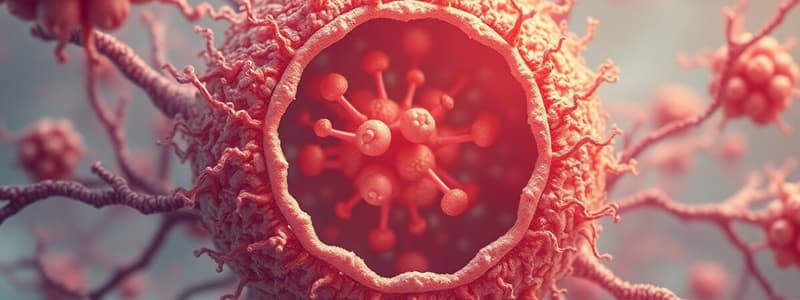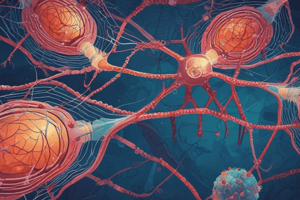Podcast
Questions and Answers
What type of cellular process is depicted in Figure 2-10?
What type of cellular process is depicted in Figure 2-10?
- Receptor-mediated endocytosis
- Exocytosis
- Phagocytosis (correct)
- Pinocytosis
What is the role of clathrin molecules in receptor-mediated endocytosis?
What is the role of clathrin molecules in receptor-mediated endocytosis?
- They act as adapter proteins, connecting the receptor to the cargo.
- They directly mediate the separation of the vesicle from the membrane.
- They form a cage-like structure around the receptor-cargo complex. (correct)
- They bind to the cargo molecule and initiate the process.
What role do antibodies play in phagocytosis?
What role do antibodies play in phagocytosis?
- Antibodies are not involved in phagocytosis.
- Antibodies facilitate the binding of the target particle to the phagocytic cell membrane. (correct)
- Antibodies directly engulf the target particle.
- Antibodies prevent the target particle from entering the cell.
What is the primary difference between constitutive and regulated secretion?
What is the primary difference between constitutive and regulated secretion?
What is the function of the cytoskeleton in phagocytosis?
What is the function of the cytoskeleton in phagocytosis?
What is the role of lysosomes in phagocytosis?
What is the role of lysosomes in phagocytosis?
Which molecule is involved in the separation of the coated vesicle from the membrane during receptor-mediated endocytosis?
Which molecule is involved in the separation of the coated vesicle from the membrane during receptor-mediated endocytosis?
Which of the following is NOT a characteristic of protein transport and vesicle traffic?
Which of the following is NOT a characteristic of protein transport and vesicle traffic?
What is the primary difference between phagocytosis and receptor-mediated endocytosis?
What is the primary difference between phagocytosis and receptor-mediated endocytosis?
What is the role of SNARE proteins in vesicle fusion?
What is the role of SNARE proteins in vesicle fusion?
What is the role of clathrin in receptor-mediated endocytosis?
What is the role of clathrin in receptor-mediated endocytosis?
What is the primary function of Rab GTPases in vesicle transport?
What is the primary function of Rab GTPases in vesicle transport?
What is the function of dynamin in receptor-mediated endocytosis?
What is the function of dynamin in receptor-mediated endocytosis?
What is the main function of exocytosis?
What is the main function of exocytosis?
What type of cells store secretory products in vesicles for future release?
What type of cells store secretory products in vesicles for future release?
Which of the following scenarios demonstrates the importance of proper SNARE interactions in cellular function?
Which of the following scenarios demonstrates the importance of proper SNARE interactions in cellular function?
What is the primary role of micro-pinocytosis in a cell?
What is the primary role of micro-pinocytosis in a cell?
Which of the following processes involves the reorganization of the actin cytoskeleton?
Which of the following processes involves the reorganization of the actin cytoskeleton?
What is the minimum size of macropinosomes formed during macro-pinocytosis?
What is the minimum size of macropinosomes formed during macro-pinocytosis?
What triggers the process of macro-pinocytosis in immune system cells?
What triggers the process of macro-pinocytosis in immune system cells?
Which type of endocytosis does not require the presence of clathrin?
Which type of endocytosis does not require the presence of clathrin?
What type of particles does phagocytosis primarily target?
What type of particles does phagocytosis primarily target?
What is the diameter of phagosomes formed during phagocytosis?
What is the diameter of phagosomes formed during phagocytosis?
Which of the following best describes the relationship between macro-pinocytosis and clathrin?
Which of the following best describes the relationship between macro-pinocytosis and clathrin?
What is the primary function of transport proteins in the membrane?
What is the primary function of transport proteins in the membrane?
Which type of endocytosis specifically involves receptor proteins to internalize substances?
Which type of endocytosis specifically involves receptor proteins to internalize substances?
Which mechanism describes the process of large molecules entering or leaving the cell through vesicles?
Which mechanism describes the process of large molecules entering or leaving the cell through vesicles?
What role do SNARE proteins play in cellular transport mechanisms?
What role do SNARE proteins play in cellular transport mechanisms?
What distinguishes active transport from passive transport?
What distinguishes active transport from passive transport?
Which type of endocytosis is characterized by the ingestion of fluid and solutes?
Which type of endocytosis is characterized by the ingestion of fluid and solutes?
What is a primary characteristic of channels in the membrane?
What is a primary characteristic of channels in the membrane?
Which of the following accurately describes exocytosis?
Which of the following accurately describes exocytosis?
What is the primary distinction between pinocytosis and phagocytosis?
What is the primary distinction between pinocytosis and phagocytosis?
Which of the following describes the function of caveolins in micropinocytosis?
Which of the following describes the function of caveolins in micropinocytosis?
What is the primary function of vesicular transport?
What is the primary function of vesicular transport?
Which of the following is NOT a type of endocytosis?
Which of the following is NOT a type of endocytosis?
What is the relationship between endocytosis and exocytosis?
What is the relationship between endocytosis and exocytosis?
Which protein plays a key role in initiating vesicle formation during clathrin-dependent endocytosis?
Which protein plays a key role in initiating vesicle formation during clathrin-dependent endocytosis?
What is the primary characteristic of micropinocytosis?
What is the primary characteristic of micropinocytosis?
Which type of endocytosis is responsible for the uptake of large particles or cells by the cell?
Which type of endocytosis is responsible for the uptake of large particles or cells by the cell?
What is the primary function of receptor-mediated endocytosis?
What is the primary function of receptor-mediated endocytosis?
What is the primary function of dynamin in micropinocytosis?
What is the primary function of dynamin in micropinocytosis?
What is the significance of caveolins in micropinocytosis?
What is the significance of caveolins in micropinocytosis?
Which of the following is NOT a true statement about endocytosis and exocytosis?
Which of the following is NOT a true statement about endocytosis and exocytosis?
Flashcards
Phagocytosis
Phagocytosis
A process where cells engulf large particles, such as bacteria, using extensions called pseudopods.
Fc receptors
Fc receptors
Receptors on phagocytic cells that recognize antibodies bound to their target antigens.
Pseudopodia
Pseudopodia
Temporary projections of eukaryotic cells used during phagocytosis to engulf particles.
Clathrin-mediated endocytosis
Clathrin-mediated endocytosis
Signup and view all the flashcards
Vesicle scission
Vesicle scission
Signup and view all the flashcards
Endocytosis
Endocytosis
Signup and view all the flashcards
Exocytosis
Exocytosis
Signup and view all the flashcards
Lysosomes
Lysosomes
Signup and view all the flashcards
Micro-Pinocytosis
Micro-Pinocytosis
Signup and view all the flashcards
Macropinosomes
Macropinosomes
Signup and view all the flashcards
Clathrin-Independent Endocytosis
Clathrin-Independent Endocytosis
Signup and view all the flashcards
Actin-Dependent Endocytosis
Actin-Dependent Endocytosis
Signup and view all the flashcards
Macro-Pinocytosis
Macro-Pinocytosis
Signup and view all the flashcards
Receptor-Mediated Process
Receptor-Mediated Process
Signup and view all the flashcards
Receptor-mediated endocytosis
Receptor-mediated endocytosis
Signup and view all the flashcards
Coated vesicle
Coated vesicle
Signup and view all the flashcards
Dynamin
Dynamin
Signup and view all the flashcards
Regulated secretion
Regulated secretion
Signup and view all the flashcards
Constitutive secretion
Constitutive secretion
Signup and view all the flashcards
SNARE proteins
SNARE proteins
Signup and view all the flashcards
Rab GTPases
Rab GTPases
Signup and view all the flashcards
Cargo molecules
Cargo molecules
Signup and view all the flashcards
Vesicular Transport
Vesicular Transport
Signup and view all the flashcards
Clathrin
Clathrin
Signup and view all the flashcards
Pinocytosis
Pinocytosis
Signup and view all the flashcards
Caveolae
Caveolae
Signup and view all the flashcards
SNAREs
SNAREs
Signup and view all the flashcards
Plasma Membrane Transport
Plasma Membrane Transport
Signup and view all the flashcards
Simple Diffusion
Simple Diffusion
Signup and view all the flashcards
Transport Proteins
Transport Proteins
Signup and view all the flashcards
Active Transport
Active Transport
Signup and view all the flashcards
Passive Transport
Passive Transport
Signup and view all the flashcards
Endocytosis Types
Endocytosis Types
Signup and view all the flashcards
Role of SNARE Proteins
Role of SNARE Proteins
Signup and view all the flashcards
Study Notes
Cellular Transport Mechanisms
- Substances enter or leave cells via various mechanisms
- Substances that are not soluble in lipids (e.g., gases) cross the plasma membrane by simple diffusion, following their concentration gradient
- Vesicular transport maintains the integrity of the plasma membrane and facilitates transfer of molecules between cell compartments
- Vesicular transport involves changes in the shape and structure of the plasma membrane, such as formation of vesicles
- Endocytosis is a general term for processes where substances enter the cell
- Exocytosis is a general term that refers to processes where substances leave the cell
- Endocytosis can be classified as receptor-mediated or non-receptor-mediated endocytosis
- In receptor-mediated endocytosis, specific receptors bind to molecules that the cell wants to take up
- Phagocytosis involves the ingestion of large particles like bacteria, while pinocytosis is a process in which small fluid-containing vesicles form
- Micropinocytosis is a type of non-receptor mediated endocytosis
- Exocytosis occurs in various cell types and is involved in secretion activities
- Exocytosis process depends on the fusion of vesicles and the plasma membrane
- In exocytosis, vesicles containing secretory products fuse with the plasma membrane, and the contents are released outside the cell
Endocytosis
- Endocytosis is a vital cellular process for transporting larger molecules, materials, and particles in to the cell
- Types of endocytosis include: receptor-mediated endocytosis, phagocytosis, and pinocytosis
- Receptor-mediated endocytosis involves specific receptors on the cell surface that bind to specific molecules
- Phagocytosis is the process of engulfing large particles. The cell will need to be highly specialized
- Pinocytosis is a process that takes up a small amount of fluids or small molecules
- Micropinocytosis is a subtype of pinocytosis specialized for taking up liquids
Exocytosis
- Exocytosis is part of the secretion process and the process of expelling molecules that have been produced inside the cell to the extracellular space
- Exocytosis can be constitutive (unregulated) or regulated
- Regulated exocytosis involves vesicles that accumulate and wait to release products under specific conditions
- Constitutive exocytosis is a continuous process of exocytosis that is not regulated; and it involves vesicles that deliver their content directly to the outside of the membrane
Studying That Suits You
Use AI to generate personalized quizzes and flashcards to suit your learning preferences.




